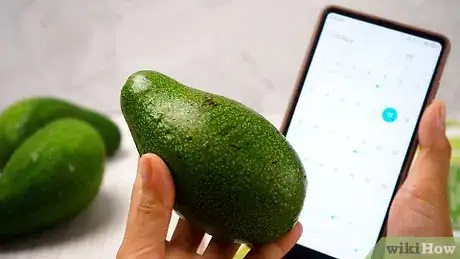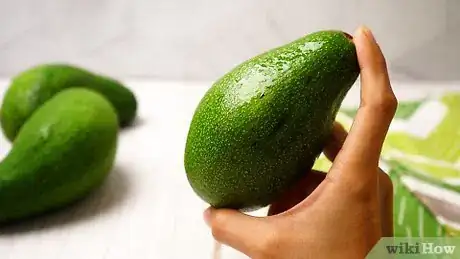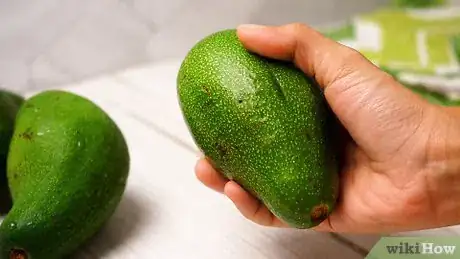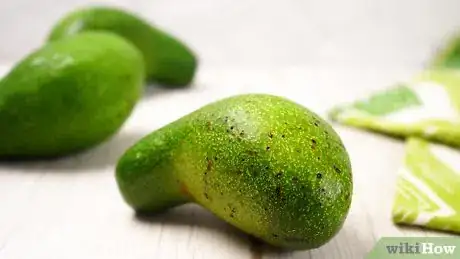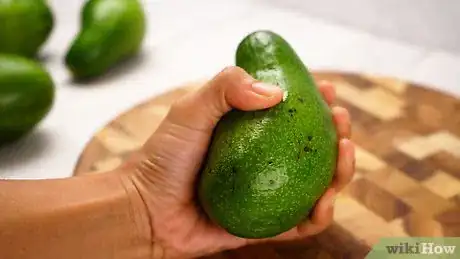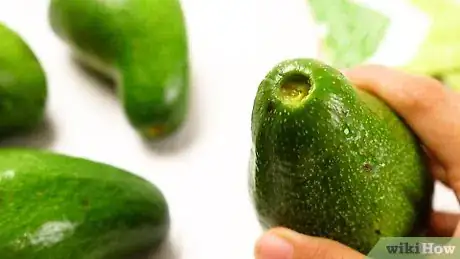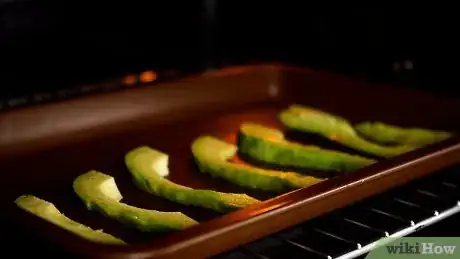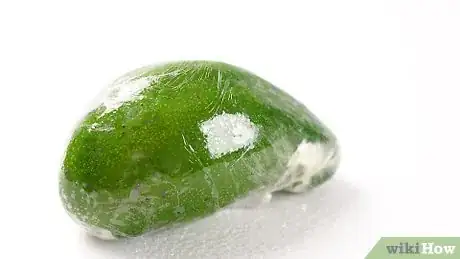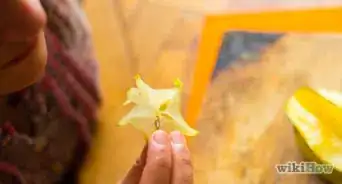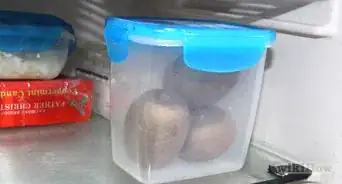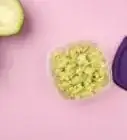This article was co-authored by Ollie George Cigliano and by wikiHow staff writer, Hannah Madden. Ollie George Cigliano is a Private Chef, Food Educator, and Owner of Ollie George Cooks, based in Long Beach, California. With over 20 years of experience, she specializes in utilizing fresh, fun ingredients and mixing traditional and innovative cooking techniques. Ollie George holds a BA in Comparative Literature from The University of California, Berkeley, and a Nutrition and Healthy Living Certificate from eCornell University.
There are 9 references cited in this article, which can be found at the bottom of the page.
wikiHow marks an article as reader-approved once it receives enough positive feedback. In this case, several readers have written to tell us that this article was helpful to them, earning it our reader-approved status.
This article has been viewed 1,023,169 times.
If you’ve ever eaten an unripe avocado, you probably know that it’s not the best idea (hard and flavorless, no thanks). Thankfully, there are a few tricks you can use to see if your avocado is ready to eat, whether you’re picking it out at the store or you’ve already brought it home. Then you’ll be on your way to enjoying a delicious avocado sandwich, guacamole dip, or an avocado snack.
Steps
Checking the Appearance
-
1Consider when the avocado was harvested. Different varieties are harvested during different parts of the season. If you’re picking out avocados in September and are given the option between a variety harvested in early fall and one harvested in late fall, the variety harvested in early fall is more likely to be ripe.[1]
- Bacon avocados are available from late fall into the spring and are considered to be a mid-winter variety.
- Fuerte avocados are also harvested from late fall through spring.
- Gwen avocados are harvested during fall and winter.
- Hass and Lamb Hass avocados are harvested year-round.
- Pinkerton avocados are available from early winter through spring.
- Reed avocados are available throughout summer and early fall.
- Zutano avocados mature between the beginning of September through early winter.
-
2Note the size and shape. Before an avocado can be ripe, it must be mature. Within each variety, a mature avocado will usually fall within a certain size range and shape.[2]
- Bacon avocados are medium in size, oval in shape, ranging from 6 to 12 oz (170 to 340 g).
- Fuerte avocados are medium to large when mature, ranging anywhere from 5 to 14 oz (142 to 397 g). They are oblong in appearance and slightly pear-shaped.
- Gwen avocados can be medium to large, plump, stout ovals, running from 6 to 15 oz (170 to 425 g).
- Hass avocados can be medium to large, ranging from 5 to 12 oz (142 to 340 g). They are also oval.
- Lamb Hass avocados are large, ranging in size from 11.75 to 18.75 oz (333 to 532 g). They are pear-shaped and symmetrical.
- Pinkerton avocados are long and pear-shaped. They weigh between 8 and 18 oz (227 and 510 g).
- Reed avocados are medium to small, ranging from 8 to 18 oz (227 to 510 g). They are the roundest variety available.
- Zutano avocados are medium to large, usually weighing between 6 and 14 oz (170 and 397 g). They are skinny and pear-shaped.
Advertisement -
3Examine the color. The color of the outer peel will be dark with most varieties, but each variety has subtle differences. Knowing which type you’re looking at can help you figure out whether it’s ripe or not.[3]
- Bacon avocados and Fuerte avocados have smooth, thin green skin.
- Gwen avocados have a dull, pliable, and pebbly green skin when ripe.
- Hass and Lamb Hass avocados have the most distinctive color. A ripe Hass avocado is deep green to purple when ripe. A black avocado will be overripe, just as a vibrant green avocado is under-ripe.
- Like Hass avocados, Pinkerton avocados deepen in color as it ripens. A ripe Pinkerton avocado will be a deep green.
- Reed avocados keep their vibrant green coloring even when ripe. The skin is usually thick with mild pebbling.
- Zutano avocados have thin, yellow-green skin when ripe.
-
4Avoid dark blemishes. Dark blemishes can be a sign of bruises or overripe spots. If you see an avocado that has spotty skin, put it back and pick out something else.[4]
- In general, check for even coloring and texture. Any avocado that is uneven, wrinkled or caves in easily has gone bad or has been damaged. Alternatively, it may feel quite light. Either way, the quality of the fruit will have gone down.
Checking the Firmness
-
1Hold the avocado in the palm of your hand. Do not grab the avocado with your fingertips. Instead, hold the fruit like you’d hold a baseball just before throwing it.[5]
- Pressing on the fruit with your fingertips can cause bruising. An unripe avocado is too hard to bruise, but a ripe avocado is not. By holding it with the palm, you spread out the pressure, thereby minimizing and reducing the risk of bruising.
-
2Gently squeeze the fruit. Use the palm and the base of the fingers to apply gentle even pressure to the avocado. You’re looking for a slight bit of give, but not too much.[6]
- When pressing the avocado, it should yield to a minimal amount of pressure if it is ripe. The skin should “give” slightly but should not remain indented.
- If the avocado feels mushy, it is overripe.
- If the avocado feels firm, it is under-ripe.
-
3Squeeze the avocado in several places. Turn the fruit a quarter of a rotation and squeeze again, once more using the palm of the hand and the base of the fingers to apply gentle pressure. Make sure you check the avocado all over, not just in one spot.[7]
- It is possible the first place pressed could be bruised, giving the impression that the avocado is ripe or overripe. To verify this, squeeze the avocado in different locations and compare the firmness of the fruit. A ripe avocado without bruises will have an even softness.
Checking Beneath the Stem
-
1Give the avocado a gentle shake. Place the avocado near your ear and lightly shake it a few times and listen for any rattling going on inside. If you hear a shaking noise, it’s probably too ripe.[8]
- If the flesh feels soft and you are worried that it might be overripe instead of merely being ripe, shaking the avocado is a way to check without cutting it open.
- The inner pit pulls away from the flesh once the fruit becomes overripe. As a result, the fruit will rattle when shaken. If you hear a rattling noise when shaking an avocado, odds are, the fruit has become overripe.
-
2Pull the stem out. With index and thumb, pinch the stem and quickly pluck it out. If the avocado is ripe, you’ll be able to pull the stem out no problem.[9]
- If the avocado is unripe, you will not be able to remove the stem. Do not use a knife or other tool to cut the stem off. If you cannot pluck off the stem with your fingers, then the avocado is not ripe and not ready to eat.
-
3Check the color beneath the stem. If the stem does twist off, look for the typical green flesh of the avocado. If it’s light yellow or brown, the avocado probably isn’t ripe yet.[10]
- If the avocado beneath the stem is a dark brown, the avocado may already be overripe.
What to Do with a Cut, Unripe Avocado
-
1Brush both sides of the avocado with lemon juice. Use a pastry brush to apply 1 tbsp (15 ml) of lemon or lime juice to the exposed cut avocado flesh.[11]
- When the avocado is cut open, you break apart the cellular walls of the flesh and trigger oxidation. The best way to slow oxidation is to apply an acidic agent to the flesh.
-
2Place the halves back together. Fit the halves back together as accurately as possible, then squeeze them tightly together. The goal here is to minimize the surface area that’s exposed to air.[12]
- To slow oxidation, minimize the amount of exposed flesh. By putting the halves together, the flesh of both sides is covered as much as possible.
-
3Tightly wrap the avocado in plastic wrap. Wrap several layers of plastic wrap around the avocado to create an airtight seal. If you don’t have plastic wrap, use an airtight container or a vacuum-sealed bag instead.[13]
- The airtight seal limits the amount of oxygen the flesh will be exposed to and slows down the oxidation process.
-
4Make avocado fries. Slice up your unripe avocado into 1⁄4 in (0.64 cm) thin slices. Spread them out on a baking sheet and cook them for 15 to 20 minutes at 400 °F (204 °C). Let your fries cool down and dip them in ranch or ketchup to enjoy a delicious, healthy snack.[14]
- You can also coat them in bread crumbs before you cook them for an added crunch.
-
5Refrigerate the avocado until it’s ripe. Since the avocado has been cut open, store it correctly in the refrigerator to prevent the fruit from going bad as it finishes ripening. It should only take a few days to soften up for the perfect texture.[15]
- If your avocado turns brown, you might need to throw it away.
Community Q&A
Did you know you can get answers researched by wikiHow Staff?
Unlock staff-researched answers by supporting wikiHow
-
QuestionHow can I tell if an avocado is soft because other shoppers have squeezed it too much, rather than being ripe?
 wikiHow Staff EditorThis answer was written by one of our trained team of researchers who validated it for accuracy and comprehensiveness.
wikiHow Staff EditorThis answer was written by one of our trained team of researchers who validated it for accuracy and comprehensiveness.
Staff Answer wikiHow Staff EditorStaff Answer
wikiHow Staff EditorStaff Answer -
QuestionCan I bake an avocado to make it ripe?
 wikiHow Staff EditorThis answer was written by one of our trained team of researchers who validated it for accuracy and comprehensiveness.
wikiHow Staff EditorThis answer was written by one of our trained team of researchers who validated it for accuracy and comprehensiveness.
Staff Answer wikiHow Staff EditorStaff Answer
wikiHow Staff EditorStaff Answer -
QuestionHow do I know what type of avocado I have?
 wikiHow Staff EditorThis answer was written by one of our trained team of researchers who validated it for accuracy and comprehensiveness.
wikiHow Staff EditorThis answer was written by one of our trained team of researchers who validated it for accuracy and comprehensiveness.
Staff Answer wikiHow Staff EditorStaff Answer
wikiHow Staff EditorStaff Answer
References
- ↑ https://www.californiaavocado.com/blog/how-to-ripen-an-avocado
- ↑ https://www.thekitchn.com/use-this-simple-trick-to-determine-whether-an-avocado-is-ripe-inside-tips-from-the-kitchn-172933
- ↑ https://www.simplyhealthyfamily.org/how-to-know-avocado-is-ripe/
- ↑ https://bamboocorefitness.com/how-to-tell-if-an-avocado-is-ripe/
- ↑ https://loveonetoday.com/how-to/pick-buy-fresh-avocados/
- ↑ https://loveonetoday.com/how-to/pick-buy-fresh-avocados/
- ↑ https://www.thekitchn.com/use-this-simple-trick-to-determine-whether-an-avocado-is-ripe-inside-tips-from-the-kitchn-172933
- ↑ https://www.thekitchn.com/use-this-simple-trick-to-determine-whether-an-avocado-is-ripe-inside-tips-from-the-kitchn-172933
- ↑ https://www.today.com/food/how-ripen-avocado-quickly-days-or-even-minutes-t126914
- ↑ https://www.thekitchn.com/use-this-simple-trick-to-determine-whether-an-avocado-is-ripe-inside-tips-from-the-kitchn-172933
- ↑ https://avocadosfrommexico.com/how-to/what-to-do-with-an-open-and-unripe-avocado/
- ↑ https://avocadosfrommexico.com/how-to/what-to-do-with-an-open-and-unripe-avocado/
- ↑ https://avocadosfrommexico.com/how-to/what-to-do-with-an-open-and-unripe-avocado/
- ↑ https://www.thekitchn.com/5-ways-underripe-avocados-can-actually-be-wonderful-to-eat-231384
- ↑ https://avocadosfrommexico.com/how-to/how-to-store-avocados/
About This Article
The easiest way to tell if an avocado is ripe is to try and pluck the stem out. If the stem comes off easily, the avocado is ripe. However, if the stem can’t be pulled out without a knife, then the avocado still needs to ripen. Check for an overripe avocado by putting it in your palm and squeezing -- if the avocado feels mushy, it’s overripe! For more tips, including how to check an avocado’s appearance for ripeness, read on!
